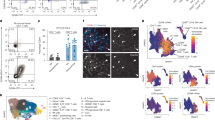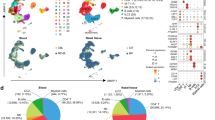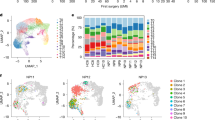Abstract
Granzymes (gzms) are key components of T-killer (Tc) cells believed to mediate pro-apoptotic activities. Recent evidence suggests that gzms also possess non-cytotoxic activities that contribute to host defense. In this study, we show that Tc cells from lymphocytic choriomeningitis virus (LCMV)-infected wild-type (wt) and gzm A/B-deficient mice express similar levels of gzmK protein, with both mouse strains efficiently controlling infection. GzmK, in recombinant form or secreted by ex vivo-derived LCMV-immune gzmAxB−/− Tc cells, lacks pro-apoptotic activity. Instead, gzmK induces primary mouse macrophages to process and secrete interleukin-1β, independent of the ATP receptor P2X7. Together with the finding that IL-1Ra (Anakinra) treatment inhibits virus elimination but not generation of cytotoxic Tc cells in wt mice, the data suggest that Tc cells control LCMV through non-cytotoxic processes that involve gzmK.
Similar content being viewed by others
Log in or create a free account to read this content
Gain free access to this article, as well as selected content from this journal and more on nature.com
or
Abbreviations
- gzm:
-
granzyme
- Hu:
-
human
- IL-1β:
-
interleukin-1 beta
- IL-1Ra:
-
IL-1 receptor antagonist (Anakinra)
- i.p.:
-
intraperitoneal
- ko:
-
knockout
- LCMV:
-
lymphocytic choriomeningitis virus
- MEF:
-
mouse embryonic fibroblast
- Mo:
-
mouse
- NK:
-
natural killer
- PEMØs:
-
peritoneal macrophages
- perf:
-
perforin
- p.i.:
-
post infection
- rec.:
-
recombinant
- SET:
-
nucleosome assembly protein
- SLO:
-
streptolysin O
- Tc:
-
T-killer cell
- wt:
-
wild type
References
Barry M, Bleackley RC . Cytotoxic T lymphocytes: all roads lead to death. Nat Rev Immunol 2002; 2: 401–409.
Grossman WJ, Revell PA, Lu ZH, Johnson H, Bredemeyer AJ, Ley TJ . The orphan granzymes of humans and mice. Curr Opin Immunol 2003; 15: 544–552.
Kramer M, Simon MM . Are proteinases functional molecules of T cells? Immunol Today 1987; 8: 140–143.
Hayes MP, Berrebi GA, Henkart PA . Induction of target cell DNA release by the cytotoxic T lymphocyte granule protease granzyme A. J Exp Med 1989; 170: 933–946.
Shi L, Kraut RP, Aebersold R, Greenberg AH . A natural killer cell granule protein that induces DNA fragmentation and apoptosis. J Exp Med 1992; 175: 553–566.
Sower LE, Froelich CJ, Allegretto N, Rose PM, Hanna WD, Klimpel GR . Extracellular activities of human granzyme A. Monocyte activation by granzyme A versus alpha-thrombin. J Immunol 1996; 156: 2585–2590.
Irmler M, Hertig S, MacDonald HR, Sadoul R, Becherer JD, Proudfoot A et al. Granzyme A is an interleukin 1 beta-converting enzyme. J Exp Med 1995; 181: 1917–1922.
Metkar SS, Menaa C, Pardo J, Wang B, Wallich R, Freudenberg M et al. Human and mouse granzyme A induce a proinflammatory cytokine response. Immunity 2008; 29: 720–733.
Beresford PJ, Xia Z, Greenberg AH, Lieberman J . Granzyme A loading induces rapid cytolysis and a novel form of DNA damage independently of caspase activation. Immunity 1999; 10: 585–594.
Mariathasan S, Monack DM . Inflammasome adaptors and sensors: intracellular regulators of infection and inflammation. Nat Rev Immunol 2007; 7: 31–40.
Anthony DA, Andrews DM, Chow M, Watt SV, House C, Akira S et al. A role for granzyme M in TLR4-driven inflammation and endotoxicosis. J Immunol 2010; 185: 1794–1803.
Bovenschen N, Quadir R, van den Berg AL, Brenkman AB, Vandenberghe I, Devreese B et al. Granzyme K displays highly restricted substrate specificity that only partially overlaps with granzyme A. J Biol Chem 2009; 284: 3504–3512.
Shi L, Kam CM, Powers JC, Aebersold R, Greenberg AH . Purification of three cytotoxic lymphocyte granule serine proteases that induce apoptosis through distinct substrate and target cell interactions. J Exp Med 1992; 176: 1521–1529.
Zhao T, Zhang H, Guo Y, Fan Z . Granzyme K directly processes Bid to release cytochrome c and endonuclease G leading to mitochondria-dependent cell death. J Biol Chem 2007; 282: 12104–12111.
Zhao T, Zhang H, Guo Y, Zhang Q, Hua G, Lu H et al. Granzyme K cleaves the nucleosome assembly protein SET to induce single-stranded DNA nicks of target cells. Cell Death Differ 2007; 14: 489–499.
Guo Y, Chen J, Zhao T, Fan Z . Granzyme K degrades the redox/DNA repair enzyme Ape1 to trigger oxidative stress of target cells leading to cytotoxicity. Mol Immunol 2008; 45: 2225–2235.
Hua G, Wang S, Zhong C, Xue P, Fan Z . Ignition of p53 bomb sensitizes tumor cells to granzyme K-mediated cytolysis. J Immunol 2009; 182: 2152–2159.
Guo Y, Chen J, Shi L, Fan Z . Valosin-containing protein cleavage by granzyme K accelerates an endoplasmic reticulum stress leading to caspase-independent cytotoxicity of target tumor cells. J Immunol 2010; 185: 5348–5359.
Bade B, Lohrmann J, ten Brinke A, Wolbink AM, Wolbink GJ, ten Berge IJ et al. Detection of soluble human granzyme K in vitro and in vivo. Eur J Immunol 2005; 35: 2940–2948.
Rucevic M, Fast LD, Jay GD, Trespalcios FM, Sucov A, Siryaporn E et al. Altered levels and molecular forms of granzyme K in plasma from septic patients. Shock 2007; 27: 488–493.
Bratke K, Klug A, Julius P, Kuepper M, Lommatzsch M, Sparmann G et al. Granzyme K: a novel mediator in acute airway inflammation. Thorax 2008; 63: 1006–1011.
Kagi D, Ledermann B, Burki K, Seiler P, Odermatt B, Olsen KJ et al. Cytotoxicity mediated by T cells and natural killer cells is greatly impaired in perforin-deficient mice. Nature 1994; 369: 31–37.
Balkow S, Kersten A, Tran TT, Stehle T, Grosse P, Museteanu C et al. Concerted action of the FasL/Fas and perforin/granzyme A and B pathways is mandatory for the development of early viral hepatitis but not for recovery from viral infection. J Virol 2001; 75: 8781–8791.
Zajac AJ, Dye JM, Quinn DG . Control of lymphocytic choriomeningitis virus infection in granzyme B deficient mice. Virology 2003; 305: 1–9.
Pardo J, Wallich R, Martin P, Urban C, Rongvaux A, Flavell RA et al. Granzyme B-induced cell death exerted by ex vivo CTL: discriminating requirements for cell death and some of its signs. Cell Death Differ 2008; 15: 567–579.
Jenkins MR, Kedzierska K, Doherty PC, Turner SJ . Heterogeneity of effector phenotype for acute phase and memory influenza A virus-specific CTL. J Immunol 2007; 179: 64–70.
Jenkins MR, Trapani JA, Doherty PC, Turner SJ . Granzyme K expressing cytotoxic T lymphocytes protects against influenza virus in granzyme AB(/) mice. Viral Immunol 2008; 21: 341–346.
Pardo J, Wallich R, Ebnet K, Iden S, Zentgraf H, Martin P et al. Granzyme B is expressed in mouse mast cells in vivo and in vitro and causes delayed cell death independent of perforin. Cell Death Differ 2007; 14: 1768–1779.
Surprenant A, North RA . Signaling at purinergic P2X receptors. Annu Rev Physiol 2009; 71: 333–359.
Martinon F, Mayor A, Tschopp J . The inflammasomes: guardians of the body. Annu Rev Immunol 2009; 27: 229–265.
So A, De Smedt T, Revaz S, Tschopp J . A pilot study of IL-1 inhibition by Anakinra in acute gout. Arthritis Res Ther 2007; 9: R28.
Pardo J, Bosque A, Brehm R, Wallich R, Naval J, Mullbacher A et al. Apoptotic pathways are selectively activated by granzyme A and/or granzyme B in CTL-mediated target cell lysis. J Cell Biol 2004; 167: 457–468.
Pardo J, Aguilo JI, Anel A, Martin P, Joeckel L, Borner C et al. The biology of cytotoxic cell granule exocytosis pathway: granzymes have evolved to induce cell death and inflammation. Microbes Infect 2009; 11: 452–459.
Chowdhury D, Lieberman J . Death by a thousand cuts: granzyme pathways of programmed cell death. Annu Rev Immunol 2008; 26: 389–420.
Froelich CJ, Pardo J, Simon MM . Granule-associated serine proteases: granzymes might not just be killer proteases. Trends Immunol 2009; 30: 117–123.
Andrade F, Fellows E, Jenne DE, Rosen A, Young CS . Granzyme H destroys the function of critical adenoviral proteins required for viral DNA replication and granzyme B inhibition. EMBO J 2007; 26: 2148–2157.
Ichinohe T, Lee HK, Ogura Y, Flavell R, Iwasaki A . Inflammasome recognition of influenza virus is essential for adaptive immune responses. J Exp Med 2009; 206: 79–87.
Mullbacher A, Waring P, Tha Hla R, Tran T, Chin S, Stehle T et al. Granzymes are the essential downstream effector molecules for the control of primary virus infections by cytolytic leukocytes. Proc Natl Acad Sci USA 1999; 96: 13950–13955.
Rode M, Balkow S, Sobek V, Brehm R, Martin P, Kersten A et al. Perforin and Fas act together in the induction of apoptosis, and both are critical in the clearance of lymphocytic choriomeningitis virus infection. J Virol 2004; 78: 12395–12405.
Martin P, Wallich R, Pardo J, Mullbacher A, Munder M, Modolell M et al. Quiescent and activated mouse granulocytes do not express granzyme A and B or perforin: similarities or differences with human polymorphonuclear leukocytes? Blood 2005; 106: 2871–2878.
Wilharm E, Parry MA, Friebel R, Tschesche H, Matschiner G, Sommerhoff CP et al. Generation of catalytically active granzyme K from Escherichia coli inclusion bodies and identification of efficient granzyme K inhibitors in human plasma. J Biol Chem 1999; 274: 27331–27337.
Pardo J, Balkow S, Anel A, Simon MM . The differential contribution of granzyme A and granzyme B in cytotoxic T lymphocyte-mediated apoptosis is determined by the quality of target cells. Eur J Immunol 2002; 32: 1980–1985.
Simon MM, Hoschutzky H, Fruth U, Simon HG, Kramer MD . Purification and characterization of a T cell specific serine proteinase (TSP-1) from cloned cytolytic T lymphocytes. EMBO J 1986; 5: 3267–3274.
Revell PA, Grossman WJ, Thomas DA, Cao X, Behl R, Ratner JA et al. Granzyme B and the downstream granzymes C and/or F are important for cytotoxic lymphocyte functions. J Immunol 2005; 174: 2124–2131.
Acknowledgements
This study was supported in part by the Excellence Initiative of the German Federal and State Governments (GSC-4, Spemann Graduate School) and by the Centre for Biological Signaling Studies (bioss, EXC 294), both supported by the Excellence Initiative of the German Federal and State Governments, and the Deutsche Forschungsgemeinschaft (BO-1933 and GRK1104). CF was supported through 5RO1AI04494-03. JP was supported by Grant SAF2008-02139 from the Ministerio de Ciencia e Innovación (Spain) and Grant PI076/08 by Gobierno de Aragón. We thank Anton Grubisic, Aynur Ekiciler, Thomas Stehle, Bettina Hartmann, Inga Clausen, Dominik Wieland, Jüri Habicht and Christiane Brenner for their expert technical assistance. We also thank Sucharit Bhakdi for his generous gift of streptolysin O and Marina Freudenberg and Chris Galanos for providing LPS.
Author information
Authors and Affiliations
Corresponding author
Ethics declarations
Competing interests
The authors declare no conflict of interest.
Additional information
Edited by J Tschopp
Supplementary Information accompanies the paper on Cell Death and Differentiation website
Rights and permissions
About this article
Cite this article
Joeckel, L., Wallich, R., Martin, P. et al. Mouse granzyme K has pro-inflammatory potential. Cell Death Differ 18, 1112–1119 (2011). https://doi.org/10.1038/cdd.2011.5
Received:
Revised:
Accepted:
Published:
Issue date:
DOI: https://doi.org/10.1038/cdd.2011.5
Keywords
This article is cited by
-
Granzyme serine proteases in inflammation and rheumatic diseases
Nature Reviews Rheumatology (2024)
-
Oral administration of oat beta-glucan preparations of different molecular weight results in regulation of genes connected with immune response in peripheral blood of rats with LPS-induced enteritis
European Journal of Nutrition (2019)
-
Anti-inflammatory activity of extensively hydrolyzed casein is mediated by granzyme B
Inflammation Research (2019)
-
Antigen-specific primed cytotoxic T cells eliminate tumour cells in vivo and prevent tumour development, regardless of the presence of anti-apoptotic mutations conferring drug resistance
Cell Death & Differentiation (2018)
-
Tissue-resident memory T cells populate the human brain
Nature Communications (2018)



